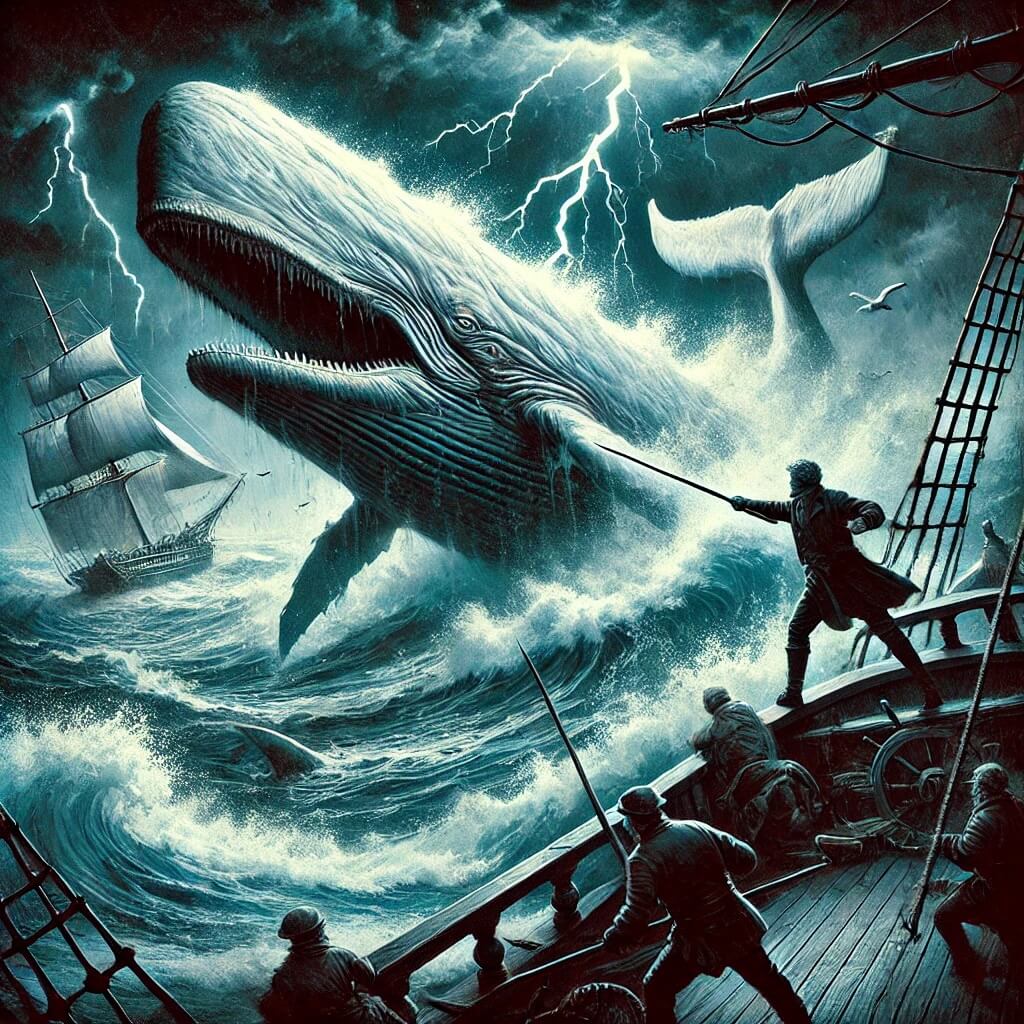Herman Melville’in Moby Dick isimli kitabının ingilizce olarak özet. Moby Dick karakterler, olaylar ingilizce anlatımı. İngilizce kitap özetleri.
Herman Melville’s Moby Dick: A Tale of Obsession and Survival
Herman Melville’s Moby Dick, published in 1851, is a timeless tale of adventure, obsession, and human struggle against nature. The novel follows Ishmael, a sailor, as he joins the whaling ship Pequod under the command of the enigmatic and obsessed Captain Ahab. The narrative explores deep themes of revenge, fate, and the limits of human endurance while chronicling the relentless pursuit of the legendary white whale, Moby Dick.

Main Characters
1. Ishmael
The narrator of the story, Ishmael is a sailor who seeks adventure on the high seas. His perspective provides both philosophical insights and vivid descriptions of life aboard the Pequod.
2. Captain Ahab
The commanding officer of the Pequod, Ahab is a one-legged, obsessive figure whose sole purpose is to hunt and kill Moby Dick. His hatred for the whale stems from a previous encounter that cost him his leg.
3. Queequeg
A skilled harpooner and Ishmael’s closest companion. Queequeg’s cultural background and camaraderie provide balance to the intensity of the journey.
4. Moby Dick
The titular whale, described as a massive, enigmatic, and seemingly malevolent creature. Moby Dick represents the uncontrollable forces of nature and fate.
5. Starbuck
The Pequod’s first mate, Starbuck is a rational and religious man who frequently opposes Ahab’s reckless obsession. He symbolizes reason amidst chaos.
6. Stub
The second mate, Stub, is a carefree and jovial figure, often bringing levity to the otherwise grim voyage.
7. Flask
The third mate, Flask, is a less significant character but plays a role in managing the crew.
8. Fedallah
Ahab’s personal harpooner, a mysterious and prophetic figure who foresees doom for the Pequod.
9. Pip
A young black cabin boy whose experiences aboard the ship lead him to madness. Pip’s tragic arc serves as a poignant commentary on the human cost of Ahab’s obsession.
Plot Summary
1. Ishmael’s Adventure Begins
The story begins with Ishmael, the narrator, seeking adventure and purpose. He befriends Queequeg, a harpooner, and the two decide to join a whaling voyage. They sign aboard the Pequod, commanded by the reclusive Captain Ahab.
2. The Crew and the Mission
Onboard, Ishmael and Queequeg meet the diverse crew, including Starbuck, Stub, Flask, and Pip. Ahab reveals that their mission is not just whaling but the obsessive pursuit of Moby Dick, the white whale that had maimed him. The crew is promised gold for killing the whale.
The Hunt for Moby Dick
3. Encounters at Sea
The Pequod travels across the world’s oceans, encountering other whaling ships. These meetings bring stories of Moby Dick’s appearances and the destruction he has caused. Each encounter reinforces Ahab’s obsession.
4. Ahab’s Growing Madness
As the journey progresses, Ahab’s focus on Moby Dick becomes increasingly unhinged. He ignores opportunities to assist other ships in distress, prioritizing his revenge over humanity and duty.
Climactic Battles with Moby Dick
5. First Encounter
After months of searching, Ahab finally spots Moby Dick. The crew attempts to harpoon the whale, but Moby smashes their boats and escapes.
6. Second Attempt
The next day, the Pequod renews its attack. The crew loses one of its members during the confrontation, and the tension aboard the ship grows.
7. The Final Battle
On the third day, Ahab succeeds in spearing Moby Dick’s side. However, the enraged whale retaliates, destroying the Pequod and killing most of the crew. Ahab himself dies when the rope of his harpoon wraps around his neck.
Ishmael’s Survival
Amidst the wreckage, Ishmael clings to a coffin-turned-lifeboat, a symbol of both death and survival. He is rescued by the Rachel, a passing ship searching for its own lost crew.
Themes in Moby Dick
1. Obsession and Revenge
Ahab’s relentless pursuit of Moby Dick highlights the destructive nature of obsession. His single-minded quest for vengeance consumes not only him but also his crew.
2. Man vs. Nature
The novel explores humanity’s struggle against the uncontrollable forces of nature. Moby Dick, as a symbol of nature’s power, underscores human vulnerability.
3. Fate and Free Will
The tension between destiny and personal choice is central to the narrative. Ahab’s actions suggest an inevitable doom, driven by both his will and external forces.
4. Isolation and Companionship
While Ishmael’s bond with Queequeg represents camaraderie, much of the novel emphasizes isolation, both physical and emotional. The vastness of the ocean mirrors the loneliness of the characters’ inner worlds.
5. Madness and Humanity
Pip’s descent into madness and Ahab’s obsessive behavior reveal the psychological toll of the journey. The novel delves into the fragility of the human mind when confronted with existential challenges.
Symbolism in Moby Dick
1. The White Whale
Moby Dick represents multiple ideas: the power of nature, the unknown, and the futility of human defiance. It is both Ahab’s nemesis and a mirror of his inner turmoil.
2. The Pequod
The ship symbolizes a microcosm of society, with its diverse crew representing various perspectives and roles.
3. The Sea
The ocean serves as a metaphor for the vast, uncharted mysteries of life and the human condition.
4. The Coffin
Queequeg’s coffin, later used as a lifeboat by Ishmael, symbolizes the thin line between life and death, as well as rebirth and survival.
Conclusion
Herman Melville’s Moby Dick is a profound exploration of human ambition, obsession, and the limits of control. Through Ishmael’s survival, the novel offers a glimmer of hope amidst tragedy, emphasizing resilience and the enduring quest for understanding. The tale of the Pequod and its doomed voyage continues to captivate readers, making Moby Dick a timeless masterpiece of American literature


